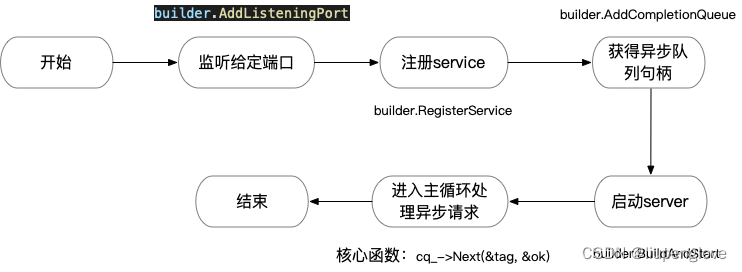tritonserver学习之二:tritonserver编译
tritonserver学习之三:tritonserver运行流程
tritonserver学习之六:自定义c++、python custom backend实践
tritonserver学习之八:redis_caches实践
1、tritonserver支持的协议
tritonserver成功将模型serve后,client端可以通过http或grpc协议请求到server端部署的模型,而对于grpc通信方式,系统选择了其异步模式,选择这种模式的原因主要有:
高并发:gRPC的异步模式允许服务器同时处理多个客户端请求,而不会因等待某个请求的响应而阻塞其他请求的处理。这使得TritonServer能够充分利用系统资源,提高并发性能,从而能够更高效地处理大量的模型推理请求。
资源利用率:在异步模式下,服务器不会为每个请求创建单独的线程或进程,而是将请求放入队列中,并通过事件循环机制来处理这些请求。这减少了系统资源的开销,使得TritonServer能够在有限的资源下处理更多的请求。
2、grpc异步模式
gRPC使用CompletionQueue API进行异步操作,基础工作流如下:
- 构建CompletionQueue,并绑定到RPC调用。
- 读写操作,使用一个唯一的void *指针(tag)标识。
- 注册处理函数,通常以类对象指针作为唯一tag。
- 调用CompletionQueue::Next,阻塞等待请求的到达。
- 请求到达后,通过tag指针进行响应处理。
grpc异步模式启动主流程:

grpc 示例代码:
void Run(uint16_t port) {
std::string server_address = absl::StrFormat("0.0.0.0:%d", port);
ServerBuilder builder;
// Listen on the given address without any authentication mechanism.
builder.AddListeningPort(server_address, grpc::InsecureServerCredentials());
// Register "service_" as the instance through which we'll communicate with
// clients. In this case it corresponds to an *asynchronous* service.
builder.RegisterService(&service_);
// Get hold of the completion queue used for the asynchronous communication
// with the gRPC runtime.
cq_ = builder.AddCompletionQueue();
// Finally assemble the server.
server_ = builder.BuildAndStart();
std::cout << "Server listening on " << server_address << std::endl;
// Proceed to the server's main loop.
HandleRpcs();
}注册处理函数:
service_->RequestSayHello(&ctx_, &request_, &responder_, cq_, cq_, this);this即为唯一的tag,为指向该对象的指针。
另外要说的是,通过builder.AddCompletionQueue函数获得异步队列,一个系统中是可以有多个的,在triton中一共使用了三个异步队列,分别用于普通请求、推理请求、流式推理请求。
server端完整示例代码:
/*
*
* Copyright 2015 gRPC authors.
*
* Licensed under the Apache License, Version 2.0 (the "License");
* you may not use this file except in compliance with the License.
* You may obtain a copy of the License at
*
* http://www.apache.org/licenses/LICENSE-2.0
*
* Unless required by applicable law or agreed to in writing, software
* distributed under the License is distributed on an "AS IS" BASIS,
* WITHOUT WARRANTIES OR CONDITIONS OF ANY KIND, either express or implied.
* See the License for the specific language governing permissions and
* limitations under the License.
*
*/
#include <iostream>
#include <memory>
#include <string>
#include <thread>
#include "absl/flags/flag.h"
#include "absl/flags/parse.h"
#include "absl/strings/str_format.h"
#include <grpc/support/log.h>
#include <grpcpp/grpcpp.h>
#ifdef BAZEL_BUILD
#include "examples/protos/helloworld.grpc.pb.h"
#else
#include "helloworld.grpc.pb.h"
#endif
ABSL_FLAG(uint16_t, port, 50051, "Server port for the service");
using grpc::Server;
using grpc::ServerAsyncResponseWriter;
using grpc::ServerBuilder;
using grpc::ServerCompletionQueue;
using grpc::ServerContext;
using grpc::Status;
using helloworld::Greeter;
using helloworld::HelloReply;
using helloworld::HelloRequest;
class ServerImpl final {
public:
~ServerImpl() {
server_->Shutdown();
// Always shutdown the completion queue after the server.
cq_->Shutdown();
}
// There is no shutdown handling in this code.
void Run(uint16_t port) {
std::string server_address = absl::StrFormat("0.0.0.0:%d", port);
ServerBuilder builder;
// Listen on the given address without any authentication mechanism.
builder.AddListeningPort(server_address, grpc::InsecureServerCredentials());
// Register "service_" as the instance through which we'll communicate with
// clients. In this case it corresponds to an *asynchronous* service.
builder.RegisterService(&service_);
// Get hold of the completion queue used for the asynchronous communication
// with the gRPC runtime.
cq_ = builder.AddCompletionQueue();
// Finally assemble the server.
server_ = builder.BuildAndStart();
std::cout << "Server listening on " << server_address << std::endl;
// Proceed to the server's main loop.
HandleRpcs();
}
private:
// Class encompasing the state and logic needed to serve a request.
class CallData {
public:
// Take in the "service" instance (in this case representing an asynchronous
// server) and the completion queue "cq" used for asynchronous communication
// with the gRPC runtime.
CallData(Greeter::AsyncService* service, ServerCompletionQueue* cq)
: service_(service), cq_(cq), responder_(&ctx_), status_(CREATE) {
// Invoke the serving logic right away.
Proceed();
}
void Proceed() {
if (status_ == CREATE) {
// Make this instance progress to the PROCESS state.
status_ = PROCESS;
// As part of the initial CREATE state, we *request* that the system
// start processing SayHello requests. In this request, "this" acts are
// the tag uniquely identifying the request (so that different CallData
// instances can serve different requests concurrently), in this case
// the memory address of this CallData instance.
service_->RequestSayHello(&ctx_, &request_, &responder_, cq_, cq_,
this);
} else if (status_ == PROCESS) {
// Spawn a new CallData instance to serve new clients while we process
// the one for this CallData. The instance will deallocate itself as
// part of its FINISH state.
new CallData(service_, cq_);
// The actual processing.
std::string prefix("Hello ");
reply_.set_message(prefix + request_.name());
// And we are done! Let the gRPC runtime know we've finished, using the
// memory address of this instance as the uniquely identifying tag for
// the event.
status_ = FINISH;
responder_.Finish(reply_, Status::OK, this);
} else {
GPR_ASSERT(status_ == FINISH);
// Once in the FINISH state, deallocate ourselves (CallData).
delete this;
}
}
private:
// The means of communication with the gRPC runtime for an asynchronous
// server.
Greeter::AsyncService* service_;
// The producer-consumer queue where for asynchronous server notifications.
ServerCompletionQueue* cq_;
// Context for the rpc, allowing to tweak aspects of it such as the use
// of compression, authentication, as well as to send metadata back to the
// client.
ServerContext ctx_;
// What we get from the client.
HelloRequest request_;
// What we send back to the client.
HelloReply reply_;
// The means to get back to the client.
ServerAsyncResponseWriter<HelloReply> responder_;
// Let's implement a tiny state machine with the following states.
enum CallStatus { CREATE, PROCESS, FINISH };
CallStatus status_; // The current serving state.
};
// This can be run in multiple threads if needed.
void HandleRpcs() {
// Spawn a new CallData instance to serve new clients.
new CallData(&service_, cq_.get());
void* tag; // uniquely identifies a request.
bool ok;
while (true) {
// Block waiting to read the next event from the completion queue. The
// event is uniquely identified by its tag, which in this case is the
// memory address of a CallData instance.
// The return value of Next should always be checked. This return value
// tells us whether there is any kind of event or cq_ is shutting down.
GPR_ASSERT(cq_->Next(&tag, &ok));
GPR_ASSERT(ok);
static_cast<CallData*>(tag)->Proceed();
}
}
std::unique_ptr<ServerCompletionQueue> cq_;
Greeter::AsyncService service_;
std::unique_ptr<Server> server_;
};
int main(int argc, char** argv) {
absl::ParseCommandLine(argc, argv);
ServerImpl server;
server.Run(absl::GetFlag(FLAGS_port));
return 0;
}
示例代码github:https://github.com/grpc/grpc/tree/master/examples/cpp/helloworld
以上示例只是简单说明了grpc异步模式的使用方法,而对于处理多类请求的情况还需要优化设计,triton的设计是非常值得推荐的。
3、triton grpc异步模式设计
triton中一共设计了三个异步队列,分别用于处理普通请求、推理请求、流式推理请求:
std::unique_ptr<::grpc::ServerCompletionQueue> common_cq_; // 普通请求
std::unique_ptr<::grpc::ServerCompletionQueue> model_infer_cq_; // 推理请求
std::unique_ptr<::grpc::ServerCompletionQueue> model_stream_infer_cq_; // 流式推理请求启动grpc服务代码位于【server】代码库main函数:
TRITONSERVER_Error*
StartGrpcService(
std::unique_ptr<triton::server::grpc::Server>* service,
const std::shared_ptr<TRITONSERVER_Server>& server,
triton::server::TraceManager* trace_manager,
const std::shared_ptr<triton::server::SharedMemoryManager>& shm_manager)
{
TRITONSERVER_Error* err = triton::server::grpc::Server::Create(
server, trace_manager, shm_manager, g_triton_params.grpc_options_,
service);
if (err == nullptr) {
err = (*service)->Start();
}
if (err != nullptr) {
service->reset();
}
return err;
}其中(*service)->Start()函数为核心函数,实现了grpc请求的注册和处理,看如下代码(grpc_server.cc):

其中common_handler_->Start()为普通grpc请求的注册,model_infer_handler->Start为推理的注册,model_stream_infer_handler->Start为流式推理请求的注册,两个推理都出在一个循环中,这个循环标识的是在多个线程中注册函数,以便实现多线程的推理。
我们以common_handler为例继续看代码的实现:
void
CommonHandler::Start()
{
// Use a barrier to make sure we don't return until thread has
// started.
auto barrier = std::make_shared<Barrier>(2);
// 启动一个线程,完成api的注册以及处理
thread_.reset(new std::thread([this, barrier] {
// 注册所有函数
SetUpAllRequests();
barrier->Wait();
void* tag;
bool ok;
// 循环等待接收请求
while (cq_->Next(&tag, &ok)) {
ICallData* call_data = static_cast<ICallData*>(tag);
if (!call_data->Process(ok)) {
LOG_VERBOSE(1) << "Done for " << call_data->Name() << ", "
<< call_data->Id();
delete call_data;
}
}
}));
barrier->Wait();
LOG_VERBOSE(1) << "Thread started for " << Name();
}新启动的线程,完成所有api的注册,并循环等待rpc请求的到达,接收到请求后,将tag进行类型转换,同时调用其成员函数:Process()进行处理。其中类:ICallData为一个基类,这个类很重要,这里先列出,但不讲解。
继续看请求的注册,以健康检查注册为例:
void
CommonHandler::RegisterHealthCheck()
{
auto OnRegisterHealthCheck =
[this](
::grpc::ServerContext* ctx,
::grpc::health::v1::HealthCheckRequest* request,
::grpc::ServerAsyncResponseWriter<
::grpc::health::v1::HealthCheckResponse>* responder,
void* tag) {
this->health_service_->RequestCheck(
ctx, request, responder, this->cq_, this->cq_, tag);
};
auto OnExecuteHealthCheck = [this](
::grpc::health::v1::HealthCheckRequest&
request,
::grpc::health::v1::HealthCheckResponse*
response,
::grpc::Status* status) {
bool live = false;
TRITONSERVER_Error* err =
TRITONSERVER_ServerIsReady(tritonserver_.get(), &live);
auto serving_status =
::grpc::health::v1::HealthCheckResponse_ServingStatus_UNKNOWN;
if (err == nullptr) {
serving_status =
live ? ::grpc::health::v1::HealthCheckResponse_ServingStatus_SERVING
: ::grpc::health::v1::
HealthCheckResponse_ServingStatus_NOT_SERVING;
}
response->set_status(serving_status);
GrpcStatusUtil::Create(status, err);
TRITONSERVER_ErrorDelete(err);
};
const std::pair<std::string, std::string>& restricted_kv =
restricted_keys_.Get(RestrictedCategory::HEALTH);
new CommonCallData<
::grpc::ServerAsyncResponseWriter<
::grpc::health::v1::HealthCheckResponse>,
::grpc::health::v1::HealthCheckRequest,
::grpc::health::v1::HealthCheckResponse>(
"Check", 0, OnRegisterHealthCheck, OnExecuteHealthCheck,
false /* async */, cq_, restricted_kv, response_delay_);
}这个函数中有三个重点:
-
OnRegisterHealthCheck变量,该变量为std::function变量,该变量实现了grpc异步api的注册。
-
OnExecuteHealthCheck变量,该变量为std::function变量,该变量为api的处理函数。
-
创建CommonCallData对象,该对象真正实现了注册、处理请求的操作。
CommonCallData类的构造函数,会调用OnRegisterHealthCheck完成api的注册,在注册时,传入的tag为CommonCallData类对象指针,唯一标识了一个api请求,这个类继承自上面所说的ICallData类,在异步队列接收到请求数据后,会将tag强制转换为一个指向ICallData基类的指针,然而其真实类型为CommonCallData,接收到请求后,通过指针调用其成员函数Process对对应的请求进行处理:
template <typename ResponderType, typename RequestType, typename ResponseType>
bool
CommonCallData<ResponderType, RequestType, ResponseType>::Process(bool rpc_ok)
{
LOG_VERBOSE(1) << "Process for " << name_ << ", rpc_ok=" << rpc_ok << ", "
<< id_ << " step " << step_;
// If RPC failed on a new request then the server is shutting down
// and so we should do nothing (including not registering for a new
// request). If RPC failed on a non-START step then there is nothing
// we can do since we one execute one step.
const bool shutdown = (!rpc_ok && (step_ == Steps::START));
if (shutdown) {
if (async_thread_.joinable()) {
async_thread_.join();
}
step_ = Steps::FINISH;
}
if (step_ == Steps::START) {
// Start a new request to replace this one...
if (!shutdown) {
new CommonCallData<ResponderType, RequestType, ResponseType>(
name_, id_ + 1, OnRegister_, OnExecute_, async_, cq_, restricted_kv_,
response_delay_);
}
if (!async_) {
// For synchronous calls, execute and write response
// here.
Execute();
WriteResponse();
} else {
// For asynchronous calls, delegate the execution to another
// thread.
step_ = Steps::ISSUED;
async_thread_ = std::thread(&CommonCallData::Execute, this);
}
} else if (step_ == Steps::WRITEREADY) {
// Will only come here for asynchronous mode.
WriteResponse();
} else if (step_ == Steps::COMPLETE) {
step_ = Steps::FINISH;
}
return step_ != Steps::FINISH;
}以上即为tritonserver grpc异步请求注册的全流程,欢迎各位程序员同学进行指正、讨论。
也非常欢迎同学们关注公众号进行沟通,一起学习,一起进步。






















 1537
1537











 被折叠的 条评论
为什么被折叠?
被折叠的 条评论
为什么被折叠?








